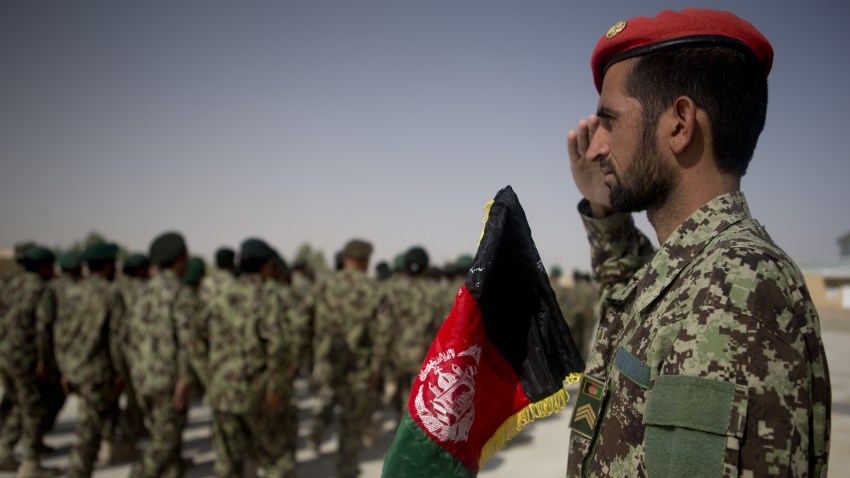The United States has “a willing partner in the next Afghan president, whichever one it is,”
said Supreme Allied Commander Europe Gen. Philip Breedlove last week. He said he was “extremely confident” that Afghanistan and the United States would be able to reach an agreement to keep in Afghanistan the 9,800 U.S. troops slated to remain there past the end of the year, when the NATO-led mission in the country officially ends.
But the U.S. footprint in the country is shrinking, and if Breedlove’s confidence is misplaced, the U.S. military presence in Afghanistan could soon go to zero. The U.S. has so far been unable to conclude with the Afghan government the bilateral security agreement required to allow U.S. troops to remain in the country after 2014. The difficulty the Obama administration has faced in securing such an agreement has worrying parallels to Iraq, where the administration failed to reach a similar agreement with the government of Prime Minister Nouri al-Maliki and withdrew its troops from the country completely at the end of 2011.
And as the world watches Islamic State in Iraq and Syria (ISIS) forces seizing territory, and weapons, from fleeing national forces in a post-America Iraq, the looming question is whether Afghan security forces, too, could dissolve in the face of a similar onslaught.
One challenge, made vivid by images of ISIS troops seizing U.S. tanks and Humvees in Iraq, will be making sure the military equipment the United States has supplied to Afghan security forces does not similarly end up in the hands of insurgents.
As of the end of March of this year, the United States had spent over $11 billion on transportation and gear for the Afghan National Army (ANA), according to a late-April
report from the office of the special inspector general for Afghanistan reconstruction (SIGAR), John Sopko. Over $5 billion was spent to procure vehicles, weapons and communications equipment for the ANA.
The report noted, however, that “determining the amount and cost of equipment provided to the ANA remains a challenge.”
As another recent
report from SIGAR highlights, not all of this equipment is well accounted for. In one instance, eight patrol boats were purchased for the Afghan National Police in 2010 at a cost of $3 million; four years later, they are still sitting in a Virginia warehouse.
In a letter to U.S. forces accompanying the report, Sopko wrote that his investigation into why the boats were procured and never delivered was “not the first time SIGAR has been confronted with lapses in record-keeping.” Beyond the issue of the patrol boats themselves, such lapses will make it difficult to keep track of what happens to the Afghan security forces’ equipment.
In an email to Trend Lines, Assistant Inspector General for Investigations Doug Domin explains that “SIGAR's investigations directorate has an initiative underway concerning the accountability of U.S. government property provided to Afghanistan.”
But a spokesman for the NATO-led International Security Assistance Force in Afghanistan (ISAF) emphasizes the contrast between the international withdrawals from Iraq and Afghanistan. “Afghanistan and Iraq are different,” says ISAF spokesman Chris Belcher in an email, pointing to the “very deliberate transition plan that leads to the Afghan government having full security responsibility by the end of 2014.”
And while U.S.-trained Iraqi troops fled in large numbers from an ISIS offensive last week, Belcher stresses that “Afghan security forces have repeatedly demonstrated their capability to secure the Afghan people.” This has allowed the mission in Afghanistan to “evolve” to focus on training, advising and assistance to the Afghan military and government. “Provided the necessary legal framework is in place,” he adds, "this advisory effort will continue well beyond 2014.”
The Obama administration appears to view Afghanistan as something of a distraction from the challenge of confronting the broader terror threat. On Monday, Secretary of State John Kerry spoke of the need to “free up some resources from an over-resourced effort in one location, Afghanistan” in an
interview with Yahoo News.
State Department spokeswoman Marie Harf
told reporters on Friday that the United States will continue to work with Afghanistan’s armed forces “to keep building their capacity.” But at the same time, she argued that the “locus right now for the terrorist threat isn’t in Afghanistan.” Recent events in Syria and Iraq are a “perfect example” of why U.S. forces need to “focus on the counterterrorism threat around the world,” she said.
For now, the administration is sticking by its approach to Afghanistan. When asked on Thursday whether events in Iraq altered the president’s view of risks in Afghanistan, White House spokesman Jay Carney gave a firm no. Violence in Iraq “does not change the approach” in Afghanistan, he said. “We are ending that combat mission this year.”

